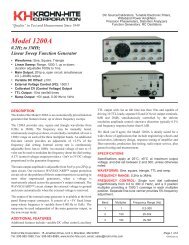3380 Manual.pdf - Krohn-Hite Corporation
3380 Manual.pdf - Krohn-Hite Corporation
3380 Manual.pdf - Krohn-Hite Corporation
You also want an ePaper? Increase the reach of your titles
YUMPU automatically turns print PDFs into web optimized ePapers that Google loves.
Model <strong>3380</strong> Series<br />
Section 2 - Operation<br />
Figure 2.3 Phase Response<br />
2.6.3 Group De lay<br />
Group delay 1 , shown in Figure 2.4, on opposite page, is defined as the derivative of radian phase with respect to radian<br />
frequency, which is the slope of the phase curve. A flat group delay is considered a linear phase response which corre -<br />
sponds to a constant slope of the phase curve. With linear phase re sponse, the dis tor tion of complex data signals will be<br />
minimized because their various frequency components, due to constant time delay, will not shift relative phase.<br />
In numeric terms, the zero frequency phase slope is –293.7°/Hz for Butterworth and –351.9°/Hz for Bessel, when normal -<br />
ized for a cutoff frequency of 1Hz. This will be 2π times greater in °/Hz for a cut off of 1 radian/sec or –1845°/Hz and<br />
–2211°/Hz respectively. Dividing by 360 converts °/Hz to radians/radians-per-sec yields a group delay time of 5.13s for<br />
Butterworth and 6.14s for Bessel.<br />
[1] IEEE Standard Dictionary of Electrical and Electronic Terms, Institute of Electrical and Electronic Engineers,<br />
IEEE-STD 100-1977, Second Edition, 1977, page 296. , shown in Figur , shown in Figur<br />
2-7

















